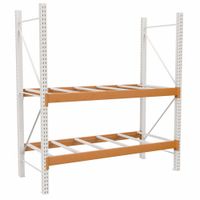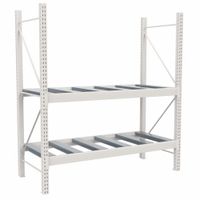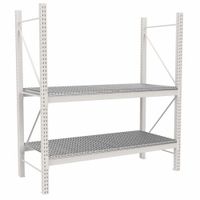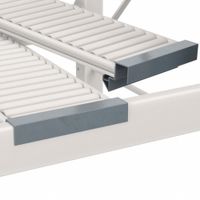Call +(254) 703 030 000 / 751 483 999 / 721 704 777
- Home
- Material Handling
- Storage Workspace
- Shelving Storage Racks
- Pallet Racks Components
.....Read More
Frequently Asked Questions
What are the different types of pallet racks?
Selective Pallet Racks: The most common type, allowing direct access to each pallet. They are cost-effective and versatile, suitable for various storage needs.
Drive-In/Drive-Through Racks: Designed for high-density storage, these racks allow forklifts to enter from one side (drive-in) or both sides (drive-through) to load and retrieve pallets. Ideal for large quantities of similar items.
Push Back Racks: These systems use a series of nested carts on inclined rails, allowing pallets to be stored several deep. When a pallet is removed, the next one automatically moves forward.
Pallet Flow Racks: Also known as gravity flow racks, they use inclined tracks with rollers to move pallets from the loading side to the picking side, ensuring first-in, first-out (FIFO) inventory management.
Cantilever Racks: Suitable for storing long, bulky items like lumber or pipes. They have arms extending from a central column, providing open access without vertical obstructions.
Double Deep Racks: An extension of selective racks, these allow pallets to be stored two deep, increasing storage density while maintaining selectivity.
Shuttle Racks: Automated systems where a shuttle moves along rails within the rack structure to load and retrieve pallets, enhancing efficiency and storage density.
Mezzanine Racks: These create additional storage levels within a warehouse, utilizing vertical space effectively. They can be customized for various storage needs.
Carton Flow Racks: Similar to pallet flow racks but designed for smaller items. They use gravity to move cartons or boxes from the loading to the picking side.
Mobile Racks: Mounted on wheeled carriages that move along tracks, these racks maximize space by eliminating fixed aisles, ideal for high-density storage.
Structural Racks: Built from heavy-duty materials, these racks are designed for storing heavy loads and can be customized for specific requirements.
How do you determine the load capacity of a pallet rack?
To determine the load capacity of a pallet rack, follow these steps:
1. **Identify Rack Specifications**: Gather details about the rack, including manufacturer specifications, model number, and design type (e.g., selective, drive-in, push-back).
2. **Check Manufacturer's Load Ratings**: Refer to the manufacturer's documentation for load ratings, which provide the maximum weight each component can support.
3. **Assess Beam Capacity**: Determine the load capacity of the horizontal beams. This is typically provided by the manufacturer and depends on the beam's length, profile, and material.
4. **Evaluate Upright Frame Capacity**: Check the load capacity of the upright frames, which depends on the height, depth, and material of the frames, as well as the number of beam levels.
5. **Consider Beam Spacing**: The distance between beam levels affects load distribution. Closer beam spacing generally increases load capacity.
6. **Account for Load Distribution**: Ensure that loads are evenly distributed across the beams. Uneven loading can reduce capacity and increase the risk of failure.
7. **Factor in Safety Margins**: Apply a safety factor, typically 1.5 to 2 times the expected load, to account for dynamic forces and potential overloading.
8. **Inspect for Damage**: Regularly inspect racks for damage or wear, which can reduce load capacity. Bent or damaged components should be repaired or replaced.
9. **Consult a Structural Engineer**: For complex systems or when in doubt, consult a structural engineer to verify load capacities and ensure compliance with safety standards.
10. **Adhere to Regulations**: Follow local building codes and industry standards, such as those from the Rack Manufacturers Institute (RMI) or Occupational Safety and Health Administration (OSHA).
By following these steps, you can accurately determine the load capacity of a pallet rack and ensure safe operation.
What are the safety guidelines for using pallet racks?
1. **Load Capacity**: Ensure racks are not overloaded. Adhere to manufacturer’s load capacity guidelines.
2. **Installation**: Follow manufacturer instructions for installation. Use professional services if necessary.
3. **Anchoring**: Secure racks to the floor to prevent tipping. Use appropriate anchors and bolts.
4. **Inspections**: Conduct regular inspections for damage, wear, or misalignment. Address issues immediately.
5. **Training**: Train employees on proper loading and unloading techniques. Emphasize safety protocols.
6. **Load Distribution**: Distribute weight evenly across shelves. Avoid placing heavier items on top.
7. **Clear Aisles**: Maintain clear aisles for safe movement of personnel and equipment.
8. **Signage**: Display load capacity and safety instructions prominently on racks.
9. **Pallet Condition**: Use only undamaged, appropriate-sized pallets. Inspect pallets regularly.
10. **Rack Protection**: Install corner guards and column protectors to minimize impact damage.
11. **Height Restrictions**: Adhere to height restrictions to maintain stability and prevent toppling.
12. **Seismic Considerations**: In seismic zones, follow additional guidelines for rack stability.
13. **Safety Barriers**: Use safety netting or bars to prevent items from falling off racks.
14. **Forklift Safety**: Ensure forklift operators are trained and cautious when maneuvering near racks.
15. **Repairs**: Conduct timely repairs using compatible parts. Avoid makeshift fixes.
16. **Lighting**: Ensure adequate lighting for visibility around racks.
17. **Emergency Access**: Keep emergency exits and equipment accessible at all times.
18. **Documentation**: Maintain records of inspections, maintenance, and training sessions.
19. **Compliance**: Follow local regulations and industry standards for rack safety.
20. **Consultation**: Seek expert advice for custom or complex racking systems.
How do you install pallet racks?
1. **Site Preparation**: Clear the area where the racks will be installed. Ensure the floor is level and can support the weight of the racks and stored items.
2. **Layout Planning**: Measure the space and plan the layout. Consider aisle width, rack height, and accessibility. Mark the floor where each rack will be placed.
3. **Gather Tools and Materials**: You will need a mallet, level, tape measure, wrench, and possibly a drill. Ensure you have all rack components: uprights, beams, and any necessary hardware.
4. **Assemble Uprights**: Stand the uprights vertically. If they are not pre-assembled, connect the vertical posts with horizontal and diagonal braces using bolts.
5. **Install Beams**: Attach the horizontal beams to the uprights at the desired height. Use a mallet to ensure they are securely seated. Check that they are level.
6. **Secure the Structure**: Once the basic frame is assembled, anchor the uprights to the floor using appropriate anchors to prevent tipping. This is crucial for safety.
7. **Add Safety Features**: Install safety bars, wire decking, or netting as needed to prevent items from falling. Consider adding column protectors or guardrails.
8. **Inspect and Adjust**: Double-check all connections and ensure everything is level and secure. Make any necessary adjustments.
9. **Load Testing**: Before full use, test the racks with a small load to ensure stability and safety.
10. **Final Inspection**: Conduct a thorough inspection to ensure compliance with safety standards and manufacturer guidelines.
11. **Training**: Train staff on proper loading techniques and weight limits to maintain safety and efficiency.
What are the benefits of using pallet racks in a warehouse?
Pallet racks offer numerous benefits in a warehouse setting, enhancing both efficiency and organization. Firstly, they maximize vertical space, allowing warehouses to store more goods without expanding their footprint. This vertical storage capability optimizes the use of available space, reducing the need for additional facilities.
Secondly, pallet racks improve inventory management. By organizing products systematically, they facilitate easier access and retrieval, which speeds up order fulfillment and reduces labor costs. This organization also minimizes the risk of product damage, as items are stored securely and are less likely to be mishandled.
Thirdly, pallet racks enhance safety. They are designed to support heavy loads and are built to withstand the rigors of a busy warehouse environment. This structural integrity reduces the risk of accidents, protecting both employees and inventory.
Additionally, pallet racks offer flexibility and scalability. They can be easily adjusted or expanded to accommodate changing inventory needs, making them a versatile solution for growing businesses. This adaptability ensures that warehouses can efficiently manage varying stock levels and product types.
Moreover, pallet racks contribute to improved workflow. By streamlining storage and retrieval processes, they reduce the time employees spend locating and handling products. This efficiency boosts overall productivity and allows for quicker response times to customer demands.
Finally, pallet racks can be cost-effective. By optimizing space and improving operational efficiency, they reduce the need for additional storage facilities and labor, leading to significant cost savings over time. This makes them a valuable investment for any warehouse looking to enhance its operations and bottom line.
How do you maintain and inspect pallet racks?
To maintain and inspect pallet racks, follow these steps:
1. **Regular Inspections**: Conduct routine visual inspections to identify any damage or misalignment. Check for bent beams, damaged uprights, and missing safety pins.
2. **Load Capacity Compliance**: Ensure that the racks are not overloaded. Adhere to the manufacturer's load capacity guidelines to prevent structural failure.
3. **Proper Installation**: Verify that racks are installed correctly, with all components securely fastened. Ensure that racks are level and anchored to the floor.
4. **Damage Assessment**: Look for signs of damage from forklifts or other equipment. Check for dents, rust, or corrosion that could compromise the integrity of the racks.
5. **Safety Features**: Ensure that safety features like beam clips and safety pins are in place and functioning. Replace any missing or damaged components immediately.
6. **Training**: Provide training for staff on proper loading techniques and the importance of not exceeding weight limits. Educate them on recognizing signs of rack damage.
7. **Clear Aisles**: Maintain clear aisles to prevent accidental collisions with racks. Ensure that there is adequate space for equipment to maneuver safely.
8. **Environmental Conditions**: Monitor environmental conditions such as humidity and temperature, which can affect the structural integrity of the racks.
9. **Documentation**: Keep detailed records of all inspections, maintenance, and repairs. This documentation can be crucial for safety audits and compliance checks.
10. **Professional Assessment**: Periodically hire a professional to conduct a thorough inspection and assessment of the racks, especially if any significant damage is detected.
By following these steps, you can ensure the safety and longevity of your pallet racks, minimizing the risk of accidents and maintaining efficient warehouse operations.
What are the common accessories and add-ons for pallet racks?
Common accessories and add-ons for pallet racks include:
1. **Wire Decking**: Provides a stable surface for storing items and enhances safety by preventing items from falling through.
2. **Row Spacers**: Maintain consistent spacing between back-to-back racks, ensuring stability and alignment.
3. **Column Protectors**: Shield the base of rack columns from damage caused by forklifts or other equipment.
4. **Safety Bars**: Installed across beams to prevent pallets from falling through, enhancing safety.
5. **Pallet Supports**: Provide additional support for pallets, especially when wire decking is not used.
6. **Back Guards**: Mesh or netting installed at the back of racks to prevent items from falling off.
7. **End-of-Aisle Protectors**: Protect the ends of racks from impact damage, often made of steel or heavy-duty plastic.
8. **Load Stops**: Prevent pallets from being pushed too far back, ensuring they remain securely on the rack.
9. **Label Holders**: Facilitate easy identification and organization of stored items.
10. **Cantilever Arms**: Extend storage capabilities for long or bulky items that do not fit on standard pallets.
11. **Drum Cradles**: Allow for the secure storage of drums or barrels on pallet racks.
12. **Dividers**: Help organize and separate different items or SKUs on the same shelf.
13. **Safety Netting**: Provides additional security by containing items within the rack structure.
14. **Lighting Systems**: Improve visibility within the racks, enhancing safety and efficiency.
15. **Mesh Decking**: Similar to wire decking but with a finer mesh, offering more support for smaller items.
16. **Seismic Bracing**: Provides additional stability in areas prone to earthquakes.
These accessories and add-ons enhance the functionality, safety, and efficiency of pallet rack systems, catering to specific storage needs and operational requirements.







